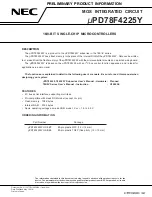DR
AFT
DR
AFT
DRAFT
DR
D
RAFT
DRAFT
DRA
FT DRAF
D
RAFT DRAFT DRAFT DRAFT DRAFT D
DRAFT
D
RAFT DRA
FT DRAFT DRAFT DRAFT DRA
UM10316_0
© NXP B.V. 2008. All rights reserved.
User manual
Rev. 00.06 — 17 December 2008
201 of 571
NXP Semiconductors
UM10316
Chapter 13: LPC29xx USB device
If a new descriptor has to be read, the DMA engine will calculate the location of the DDP
for this endpoint and will fetch the start address of the DD from this location. A DD start
address at location zero is considered invalid. In this case the NDDR interrupt is raised.
All other word-aligned addresses are considered valid.
When the DD is fetched, the DD status word (word 3) is read first and the status of the
DD_retired bit is checked. If not set, DDP points to a valid DD. If DD_retired is set, the
DMA engine will read the control word (word 1) of the DD.
If Next_DD_valid bit is set, the DMA engine will fetch the Next_DD_pointer field (word 0)
of the DD and load it to the DDP. The new DDP is written to the UDCA area.
The full DD (4 words) will then be fetched from the address in the DDP. The DD will give
the details of the DMA transfer to be done. The DMA engine will load its hardware
resources with the information fetched from the DD (start address, DMA count etc.).
If Next_DD_valid is not set and DD_retired bit is set, the DMA engine raises the NDDR
interrupt for this endpoint and clears the corresponding EPxx_DMA_ENABLE bit.
14.5.3 Transferring the data
For OUT endpoints, the current packet is read from the EP_RAM by the DMA Engine and
transferred to the USB RAM memory locations starting from DMA_buffer_start_addr. For
IN endpoints, the data is fetched from the USB RAM at DMA_buffer_start_addr and
written to the EP_RAM. The DMA_buffer_start_addr and Present_DMA_count fields are
updated after each packet is transferred.
14.5.4 Optimizing descriptor fetch
A DMA transfer normally involves multiple packet transfers. Hardware will not re-fetch a
new DD from memory unless the endpoint changes. To indicate an ongoing multi-packet
transfer, hardware sets an an internal flag called DMA_PROCEED.
The DMA_PROCEED flag is cleared after the required number of bytes specified in the
DMA_buffer_length field is transferred. It is also cleared when the software writes into the
USBEpDMADis register. The ability to clear the DMA_PROCEED flag allows software to
to force the DD to be re-fetched for the next packet transfer. Writing all zeros into the
USBEpDMADis register clears the DMA_PROCEED flag without disabling DMA operation
for any endpoint.
14.5.5 Ending the packet transfer
On completing a packet transfer, the DMA engine writes back the DD with updated status
information to the same memory location from where it was read. The
DMA_buffer_start_addr, Present_DMA_count, and the DD_status fields in the DD are
updated.
A DD can have the following types of completion:
Normal completion
- If the current packet is fully transferred and the
Present_DMA_count field equals the DMA_buffer_length, the DD has completed
normally. The DD will be written back to memory with DD_retired set and DD_status set
to NormalCompletion. The EOT interrupt is raised for this endpoint.


















